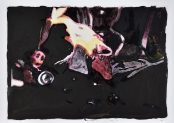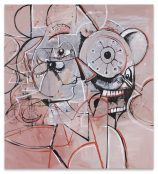Dylan Martinez came to Trebuchet’s attention in our search for artists using glass not as a conceptual adjunct but as a direct medium. Simple and realistic, his sculptures of water-filled plastic bags in clear glass (H20/Si02, 2020) have a direct and universally irresistible impact.
Everyone immediately understands what the sculptures are about. You think it’s one thing and then it isn’t; the medium gives it that second layer.
The elevation of realistic objects into a higher artistic realm by transposing them to a secondary medium isn’t new and dates back to prehistory, when inspiration dictated a figure from rough clay. Reflected in several origin myths, this act of creation prompts the question: why that particular medium? From peoples as diverse as Māori to Inca and Egyptian to Yoruba, what is it about clay that makes it a specifically suitable substance for the foundation of humanity?
The properties of glass presuppose a set of meanings and paradoxes; transparency, fluidity, delicacies, danger, factors of strength or weakness and sophistication allow both a surface and counterfactual reading by the viewer. Martinez’s work plays against the tropes of his medium, questioning the transpositional nature of art by using the transparency of glass to highlight the opacity of our shared vision. To what extent do we see the same thing?
“Glass is a remarkable material. It is so versatile in its capabilities and has become ubiquitous in our modern lives. It is responsible for major technical achievements, like instantaneous global communications, and is used for more simplistic purposes like home insulation and everything in-between.
When I was first exposed to hot-glass-blowing it was truly a unique craft. Melted at over 2,000 degrees F, hot glass has a viscosity close to honey. Once a glob of glass is spun onto the end of an iron rod you must continuously rotate the rod to balance the falling glass to keep it on centre as well as to keep it from falling on the floor. Add several other parameters that you must compensate for and you will discover that creating refined forms requires at least seven years of experience.
For me, the discipline of mastering the material and the focus and dedication it takes to execute one’s designs keeps me striving. Glass-making is a meditation for me. All distractions must be ignored, and you must not falter on any step or take any breaks before the piece is completed. The intimacy of working with the glass is essential.
As a medium, glass can take on almost any form and it manipulates light unlike any material; the possibilities are endless. My optical and trompe l’œil artworks reflect my interest in the manipulation of perception. Whether through the physiology of sight or the psychology of the mind, I use glass as a mechanism of blurring those functions.

The aim of art is to represent not the outward appearance of things, but their inward significance. – Aristotle

















